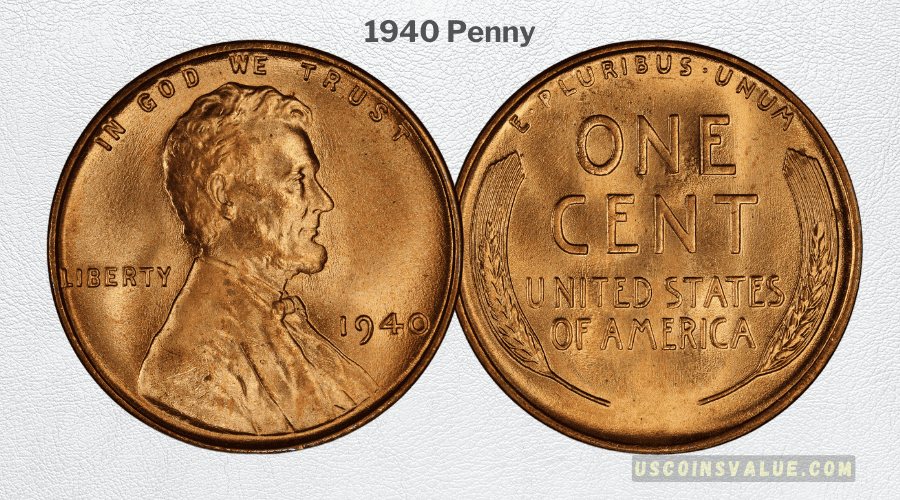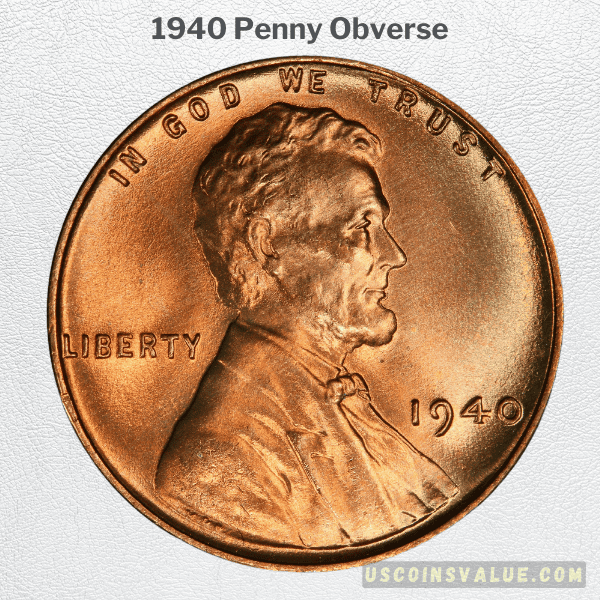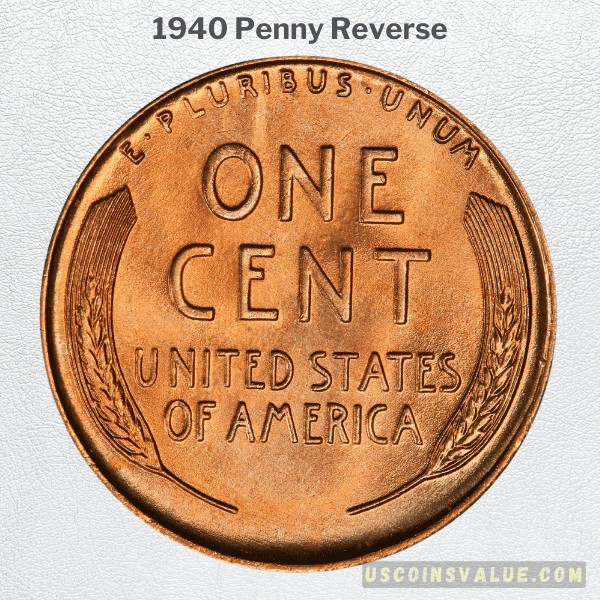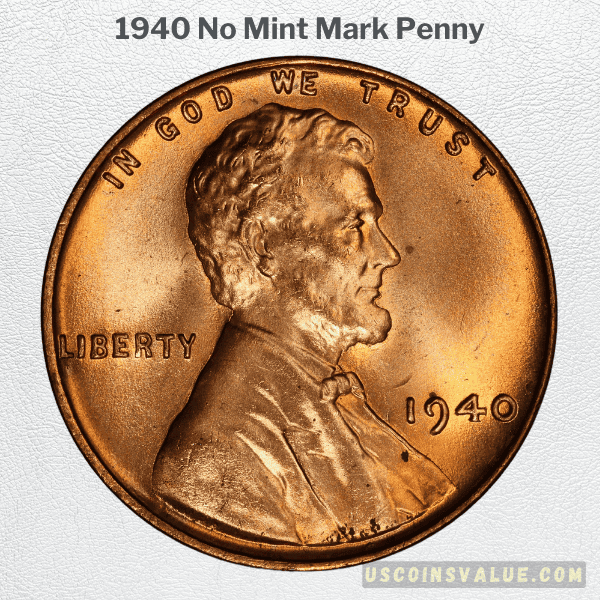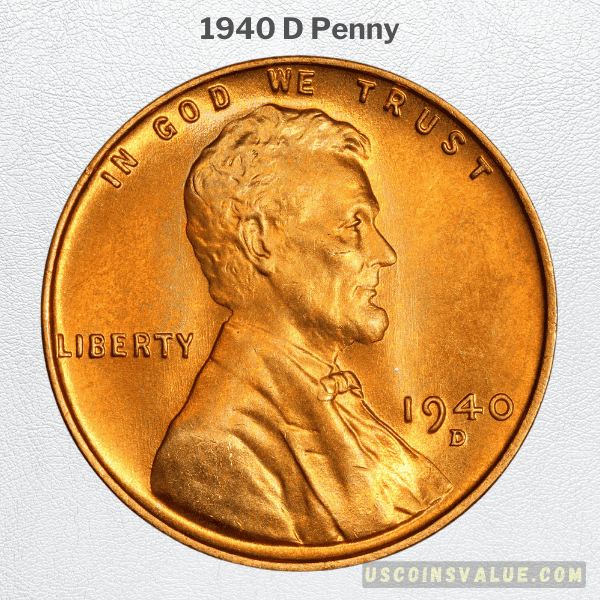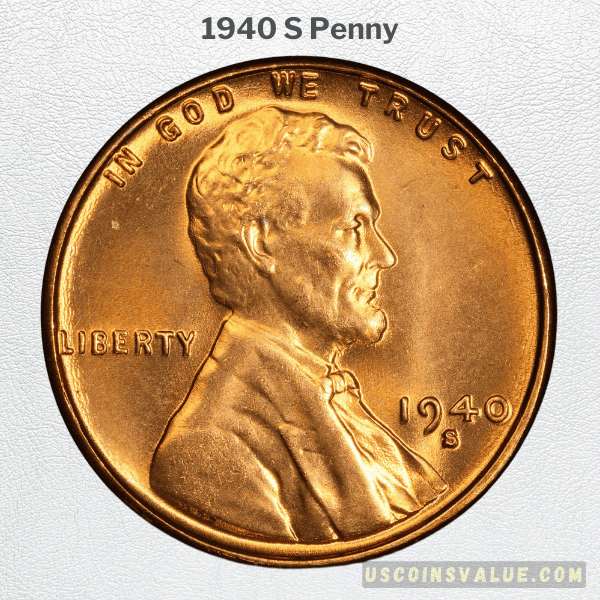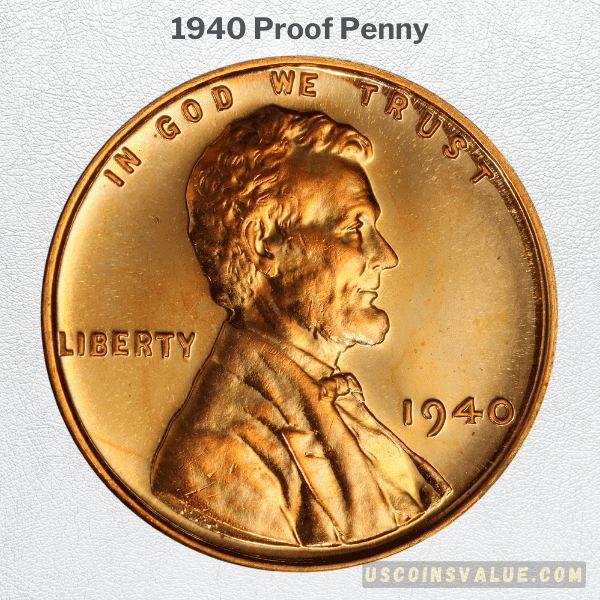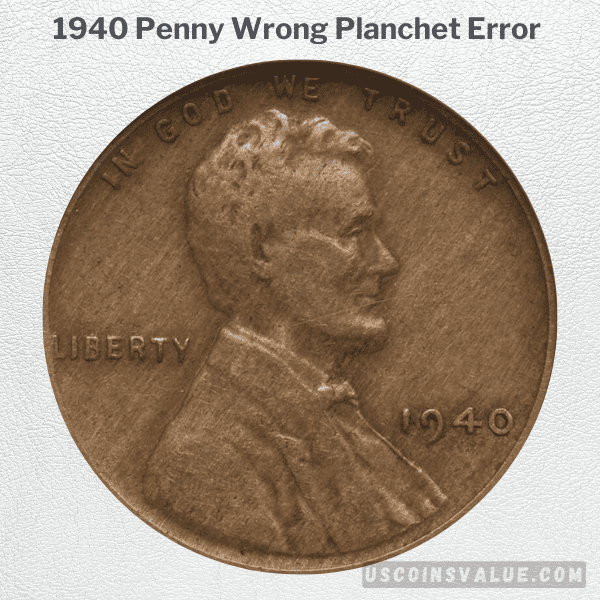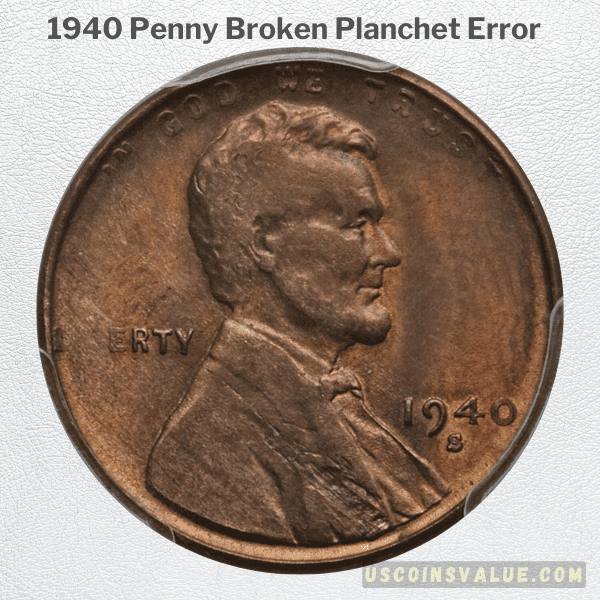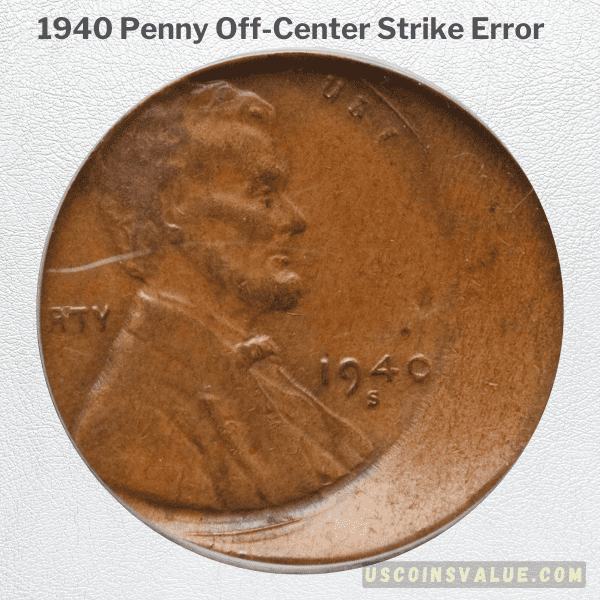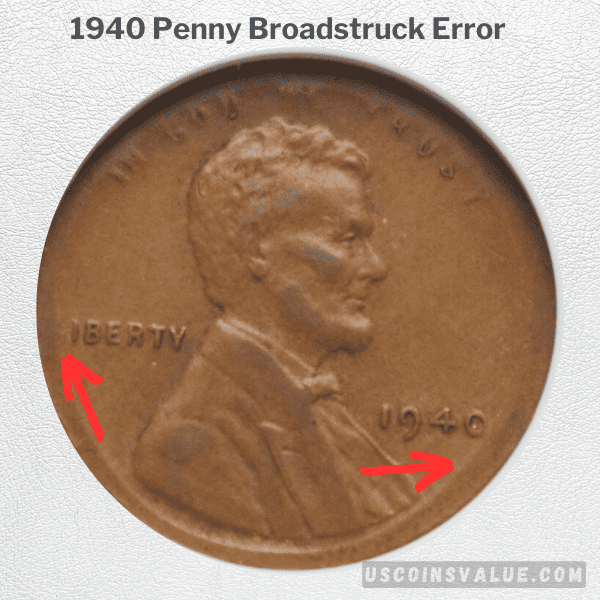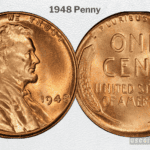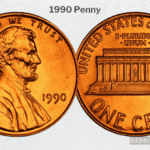Do you have your eyes set on adding the 1940 Wheat Penny to your collection? Or have you got some in your collection and are interested in discovering if it is worth keeping? Then you’re in the right place.
The Wheat Penny is valuable because it’s one of the most extended-running series with unique variants. Today, it’ll cost you at least $0.20 to collect an average condition 1940 Wheat Penny and about $2 – $4 for a mint state grade.
That’s a good bargain for a historical coin like the Lincoln cent.
Here’s everything you need to know about this coin, from its physical features and estimated market value.
What is the Background of the 1940 Wheat Penny?
Production of the Lincoln series began in 1909 after the production of the Indian Head design ended, and it lasted until 1958. Victor David Brenner was the new Chief engraver at the US Mint, and he designed the obverse and reverse of the Lincoln (Wheat) Penny.
1940 marked the 6th highest year for wheat cent mintage in history. This year, 600 million pieces of the Lincoln Penny were produced in the Philadelphia mint, and because it’s been over sixty years since the production of the 1940 Wheat pennies, you’ll typically find them at auctions, estate yard sales, or collection fairs.
As a new collector, you must know what this vintage coin looks like and its current market value before trading.
The 1940 Wheat Penny Features
- Series: Wheat | Lincoln
- Year of Make: 1940
- Mintage: 586,810,000
- Mint Branch: Philadelphia
- Composition: 95% Copper, 5% Tin & Zinc (Bronze)
- Weight: 3.11g
- Diameter: 19 mm
- Edge: Plain
Obverse & Reverse Design of the 1940 Lincoln Penny
The engravings on the obverse and reverse of the 1940 penny are the inspiration behind the two names this popular coin goes by in the numismatic world. On the obverse (front or head), you’ll find an image of former President Abraham Lincoln’s side profile from his head to his half-upper body.
Lincoln’s head faces right, his hair cropped in short curls while he wears a classic three-piece suit. The engraving only shows the outline of his outer blazer shirt and a partial view of his tie. He has a stern look and a sharp jawline while the field (background) remains plain.
Other details on the obverse include:
- IN GOD WE TRUST: A small but visible “IN GOD WE TRUST” engraving is on the center upper curve over Lincoln’s head.
- LIBERTY: Behind the ex-president’s neck and slightly above his back shoulder, there’s a small font saying, “LIBERTY”.
- 1940: By Lincoln’s breast pocket, placed lower than the “LIBERTY” engraving, you’ll see the production year, “1940”.
- Mint Mark: “D” for Denver, “S” for San Francisco placed under the 1940 between “9” and “4”.
Meanwhile, the reverse has the following details, including two wheat stalks:
- E PLURIBUS UNUM: There’s a small but visible engraving of “E.PLURIBUS.UNUM” in the center of the upper curve.
- ONE CENT: A bolder engraving of “ONE” over “CENT” is under the tiny “E PLURIBUS UNUM.”
- UNITED STATES OF AMERICA: Under “ONE CENT,” there’s another engraving of “UNITED STATES” over “OF AMERICA” in the same font.
- Two Wheat Stalks: Single wheat stalks enclose the “ONE CENT” and “UNITED STATES OF AMERICA” engravings on both sides. The left stalk stops by “E” and the right one by “M” of “E PLURIBUS UNUM.” But the stems leave a small space in the center because they don’t touch.
1940 Wheat Penny Varieties
Knowledge of the varieties of the 1940 Wheat Penny is crucial in helping to understand why their values differ.
There are two main types of 1940 Lincoln cents — Regular Strike and Proof.
All the coins have the same bronze composite made from 95% Copper & 5% Tin and Zinc.
Here is a table showing the varieties of the 1940 Lincoln penny.
| 1940 (Lincoln Wheat) Varieties | Mint Location | Mintage |
| 1940 (Regular Strike) | Philadelphia | 586,810,000 |
| 1940-D | Denver | 81,390,000 |
| 1940-S | San Francisco | 112,940,000 |
| 1940 (Proof Strike) | Philadelphia | 15,872 |
Regular Strike (1940, 1940-S, 1940-D) Wheat Penny
Regular Strike coins underwent standard procedure during production and immediately entered circulation. The different features are in the mint marks and colors.
You can find a 1940 Wheat Penny in any of three colors, including red, brown, and red-brown.
Proof 1940 Wheat Penny
Proof coins were the first samples of a new coin series. Minting factories used them to test the dies before using them on the regular strike coins meant for circulation. Because of their intended purposes, Minting factories made a limited number of Proof coins.
They typically came in regular red, brown, or red-brown colors, but sometimes there was a fourth type — Cameo. Cameo Proof coins used the newest dies and planchets to create the shiniest versions.
What’s the Current Value of the 1940 Wheat Penny?
Due to their unique luster and quality, Proof 1940 Wheat Pennies are rare and the most valuable, especially in the highest quality of PR67. In 2021, a PR67 piece sold for $5,520.
The MS68 regular strike 1940 Wheat Pennies rival its value because one sold for $3,360 in 2023 and another for $8,050 in 2022.
New coin collectors don’t have to panic about starting a 1940 Wheat Penny, a.k.a. Lincoln Cent collection; this is because getting a new regular strike piece for less than $4 is relatively easy. However, you’ll need six times that amount for a Proof variety.
Also, note that you can’t find specific grades in some colors. For example, there’s no brown 1940 Wheat Penny record in MS63 grade and above. The highest graded brown color 1940 Wheat penny sold was an MS62 piece in 2006 for $805.
See the table for a breakdown.
| 1940 Wheat Penny Grades | 1940 Wheat Penny (Regular Strike MS) | 1940 Wheat Penny (Proof) | 1940-D Wheat Penny (Regular Strike MS) | 1940-S Wheat Penny (Regular Strike MS) |
| 60 | $2.33 | $25 – $100 | $4 | $4 |
| 61 | $3 | $30 – $150 | $4 | $4 |
| 62 | $4 | $26 – $325 | $5 | $6 |
| 63 | $3.38 – $6 | $35 – $825 | $10 | $10 |
| 64 | $17 | $50 – $1,850 | $16 | $18 |
| 65 | $28 | $65 – $4,000 | $32 | $30 |
| 66 | $45 | $235 – $6,500 | $65 | $65 |
| 67 | $1,650 | $4,850 – $15,000 | $950 | $800 |
| 68 | $9,000 | N/A | $10,000 | $10,000 |
1940 Regular Strike (No Mint Mark) Wheat Penny
You can get a regular strike 1940 Wheat Penny for as low as $2.33 if it’s in MS60 condition. It won’t be the shiniest, but you’d still see the details. As a seller, you’ll need an MS67 regular strike 1940 Lincoln Cent to make at least $1,000.
The auction record for a regular strike 1940 Wheat penny is $11,500 for an MS68 red coin. It sold in 2011, which is about 12 years ago. However, auction firms have made thousands of dollars selling 1940 Wheat head pennies in the last five to eight years.
David Lawrence RC sold an MS68 grade in red for $8,050 in 2022, much more than Heritage Auctions made in 2023. In 2019, Heritage Auctions sold a similar coin for $6,600.
Regular strike 1940 Wheat pennies are less valuable than the proof variant. You’ll need an MS67 or higher grade to make at least $1,000 at auction. Otherwise, you might make as low as $2.33.
| Grade | Highest Price & Sale Date | Firm |
| MS68, RD | $8,050 (2022) | David Lawrence RC |
| MS68, RD | $6,600 (2019) | Heritage Auctions |
| MS68, RD | $3,360 (2023) | Heritage Auctions |
| MS67+ | $1,998 (2015) | Heritage Auctions |
| MS67+ | $1,410 (2015) | Heritage Auctions |
1940-D Wheat Penny (Regular Strike)
1940-D Wheat Pennies were lucrative in 2018 and 2019 as those years recorded sales in thousands of dollars. Heritage Auctions sold an MS67, RD 1940-D coin for $1,440 and $1,560 in 2019. The previous year, the firm made the auction record of $3,120.
This year, the highest sale was barely over $1,000 for an MS67+, RD 1940-D Wheat Penny. See more sales below:
| Grade | Highest Price & Sale Date | Firm |
| MS67+, RD | $3,120 (2018) | Heritage Auctions |
| MS67+, RD | $1,320 (2019) | Heritage Auctions |
| MS67+, RD | $1,260 (2019) | Heritage Auctions |
| MS67+, RD | $1,110 (2020) | Heritage Auctions |
| MS67+, RD | $1,080 (2023) | Heritage Auctions |
1940-S Wheat Penny (Regular Strike)
Unfortunately, statistics show that the prime market for the 1940-S Wheat Penny ended in 2018. It recorded its highest sale at almost $10,000 by Stack’s Bowers for a rare MS68 red 1940-S coin.
Before then, the late 2010s saw a couple of $1,000+ sales, like in 2015, 2016, and once in 2022. Sales in 2023 dwindled to hundreds of dollars, with the highest being $174. That month, Heritage Auctions also sold similar MS67, RD 1940-S coins for $104 and $134.
See more prices below:
| Grade | Highest Price & Sale Date | Firm |
| MS68, RD | $9,600 (2018) | Stack’s Bowers |
| MS67+ | S1,880 (2015) | Heritage Auctions |
| MS67+, RD | $1,293 (2016) | Heritage Auctions |
| MS67+, RD | $1,116 (2016) | Heritage Auctions |
| MS7+, RD | $1,080 (2022) | Heritage Auctions |
1940 Wheat Penny (Proof Strike)
Heritage Auctions auction record for the Proof variant of the 1940 Wheat penny was $11,163 in 2017. In 2023, the highest amount Heritage Auctions got for a PR67 piece was $1,680.
In recent years, Heritage Auctions sold the most Proof 1940 Wheat Pennies at auction, and they rang in over $1,000. In 2021, a CAM PR65 sold for $2,160 in the firm. Note, however, that the pricey Proof coins had PR67 or 67+ grades.
Stack’s Bowers sold a red PR67 1940 Wheat head penny for $3,120 in 2019. Statistics show you can make at least $1,000 for today’s market’s highest-graded Proof 1940 Wheat penny.
This table shows the prices for 1940 Wheat head pennies in the last six years, their grades, and the firms that sold them.
| Grade | Highest Price & Sale Date | Firm |
| PR67+, RD | $11,163 (2017) | Heritage Auctions |
| PR67, RD | $5,520 (2021) | Heritage Auctions |
| PR67, RD | $4,320 (2019) | Heritage Auctions |
| PR67+, RD | $4,200 (2021) | Heritage Auctions |
| PR67, RD | $3,995 (2019) | Legend Rare Auction Coins |
Common Errors You’ll Find in a 1940 Wheat Penny
There’s always room for human and machine error, so some 1940 Wheat pennies didn’t come out ideally. Back then, an error meant a recall from circulation, but in today’s market, it means more money for a coin seller.
Here are some popular errors on vintage coins like the 1940 Lincoln cent.
- Wrong Planchet Error
- Broken Planchet Error
- Off-Center Strike Error
- Broadstruck Error
Wrong Planchet Error
Every coin series and denomination has a customized planchet to create the perfect features and coordinate the strike. Striking a coin series on the wrong planchet leads to differences in characteristics from the coloring to the sizing.
When your 1940 Lincoln Cent has a color other than bronze composite, that’s a sign of wrong planchet error. You can still make money selling it, though.
- In 2005, Heritage Auctions sold a 1940 1C Lincoln coin struck on 88.5 Copper and 11.5 silver planchet for $299.
- In 2011, a Lincoln cent struck on a brass planchet sold for $149.50.
Broken Planchet Error
Sometimes, the minting machine may have the right planchet but is damaged. The strike will still go through when this happens, but the resulting coin will look odd. It may be too thin or have a split where the planchet’s damage occurred.
With this error, it’ll cost you more than $70 to buy a 1940 Lincoln cent.
- This year (2023), Heritage Auctions sold a Lincoln cent struck on a split planchet for $79.
- A 1940-S Lincoln penny struck on a thin planchet sold for $89 in 2015.
Off-Center Strike Error
Shifted planchets and strikes lead to disproportionate engravings on a coin. When this happens, coin collectors say the coin has an “off-center strike” error. The shift may be slight at 5% or as much as 80%.
The wider the error, the more empty fields (background) you’ll see on your coin and the more valuable it becomes.
- In 2022, a 1940-S Lincoln cent struck 25% off-center and sold for $81.
- A 1940 Wheat Penny struck 20% off-center sold that same Jan 2022 for $80.
- Heritage Auctions sold a 1940 1C Lincoln coin struck 40% off-center for $204.
Broadstruck Error
A broadstruck error happens when the retaining collar meant to hold a planchet in place expands. It causes it to move, hitting the die strike outside the designated areas. Coins with this error have engravings in the wrong spots with raised circumferences.
It can be slight or extreme, depending on how loose the retaining collar got. Selling a broadstruck error 1940 Lincoln cent will still make you some money.
- A broadstruck with 40% curved clip 1940 Lincoln cent in MS64 grade sold for $324 in 2021.
- A lesser grade (AU53) broadstruck 1940 Lincoln cent sold for way less at $42.
- In 2021, another 1940-S Lincoln Cent with a broadstruck error sold for $89.
Final Thoughts
The Lincoln Cent isn’t a gold mine in resale value like other series, but it will make you thousands of dollars if you’ve got the correct information. There are many varieties to choose from as a new numismatic enthusiast.
Also, you’re more likely to find a red 1940 regular strike Wheat Penny than any other variant. But it’s also the most “expensive” to buy. Instead, it’s best to start small with the brown variants and build up to the rare Proof Cam 1940 Wheat Penny when you become knowledgeable.

